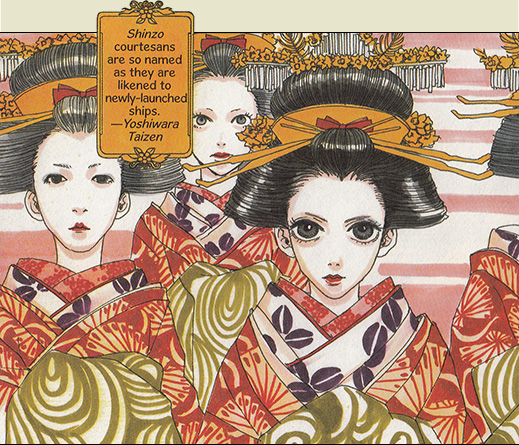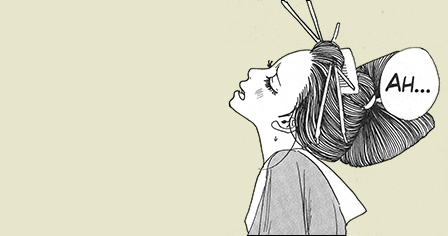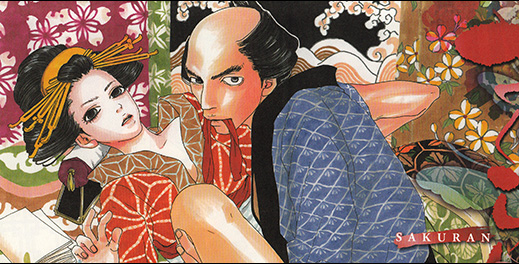Sakuran: Blossoms Wild
 Introducing Kiyoha: first-time smoker
Introducing Kiyoha: first-time smoker
(comment courtesy of Katie Jett Walls)
I care about women. And not just because they're mine or I have some familial duty to the ones who are related to me. I care about women because somewhere over the last twenty years, I began to empathize with them. Not all at once probably, but gradually. It came along with being able to empathize with all sorts of people who were not me.
When I was twenty, I didn't get people. At all. I found everyone obnoxious and dull. I liked girls, sure, but only because I wanted to eventually carve myself into their lustrous flesh.11Metaphorically speaking, of course. I wasn't the greatest of people when it came to other people. I spent my childhood and teen years painfully shy, unable to make many friendships and so: unable to really get the knack of understanding how and why others might feel the things they might feel. I attribute this lack of empathy to something beyond the mere fact of my awkward introversions. I could have still learned to understand people had only I kept reading. But I didn't.
I had been a voracious devourer of books up until junior high when suddenly my book-nerdiness became a social liability. I stopped reading lit entirely and instead picked up comics, which were dumb enough not to seem Smart. Dorky but not nerdy.22The distinction was important to me back then. A relevant fallout of this decision was that I was no longer reading the books that would have taught me to relate to characters of complex motivations and differing cultural foundations. Instead, I wallowed in seven years of cardboard characters with unrealistic motivations and monolithic concerns. It wasn't comics that made me unsympathetic, but they sure didn't help.
(Comics in that era, of course, were nowhere near so varied or valuable as they are today. Three cheers for progress toward the visio-narrative utopia, eh?)
In any case, when I hit age twenty I realized my social survival no longer depended on pretending not to like books—so I jumped right back in. I gradually began, with the help of fictional figures voicing the concerns of real authors, to soften. It was a slow road. I began to better understand people who were not me—or at least to apprehend that it was okay that they were not me. Fellow Americans of different cultural backgrounds, then people of ethnicities that were not straight-up Caucasian, then those outside the heterosexual spectrum, then those of foreign soil, then believers in different gods and ideologies. And then women. The order might be off but then again it might not. Regardless, over the nearly two decades that passed after my twentieth birthday, I grew a lot as a human and am thankful for the books that lit my path.
And now all that is to say: when I approach a book like Sakuran, the experience is emotional for me. Moyoco Anno's book is about women in distressing circumstances, and throughout I felt the weight of the whole history that has arrayed itself against the female existence. I think of my wife, my daughter, my mother, my friends, women I know from the internet, and women I don't know at all and will never know. Societies over the long centuries and societies in this very moment have not made living the kindest of experiences for women—societies governed and purposed by my people, by men. I hate us for these inequities and a book like Sakuran fills me with tidal waves of regret and sadness, even if that is not its purpose.
 That right there kind of just
That right there kind of just
makes you want to throw up on everybody forever
Moyoco Anno's Sakuran concerns Kiyoha, an 18th-century courtesan who is destined (by Anno's pen) to become the most celebrated of all the houses in Yoshiwara.33Yoshiwara was the famous pleasure district in Edo (present-day Tokyo). Its houses of prostitution form the background for numerous literary works concerned with the era. Anno begins by introducing Kiyoha as she nears the height of her fame and then peels back for the rest of the book to chart the woman's course across what turns out to be a hard and bitter sea. Kiyoha is a "strong" female character in the sense that she survives to better herself through her experiences; but simultaneously, she is not immune to her circumstances and her life of prostitution under contract to her house takes evident toll on her. She realizes the world she's trapped by is terrible and makes the best of it, but she never shies away from acknowledging the reality that her role as courtesan is dominated by paternal influences.
 Kiyoha, being paternally influenced
Kiyoha, being paternally influenced
This is my first experience of Anno's artwork and it took me rather off-guard. Sakuran's art is bizarre and kind of wonderful. Her figurework is hyper-limber and her poses extend into a vibrant sort of grotesque.44Tip of hat to Tom Spurgeon's review that made this description click for me. Characters motivate through a series of light physical impossibilities that work to provoke a sense of awkwardness that mirror Sakuran's narrative force. For those who critique manga for the Japanese creators' penchant for focusing too much on the eyes as a conveyance for emotion,55An unhelpful and boring critique, even when phrased more obliquely as: I don't like manga because their eyes are so big. The complaint nearly always falls flat as a strange sort of hypocrisy because American cartoon styles (such as, say, Disney's used in Beauty & the Beast) use oversized eyes extensively as well, and generally not to so attentive effect as many examples of manga. the eyes in Anno's work will be awestriking. Belle's eyes in Beauty & the Beast are much larger than the average manga character's, and Kiyoha's eyes in Sakuran are much larger than Belle's. We've heard the cliché of a person's eyes being pools and The Lovely Bones introduced the treacle nickname "Ocean Eyes." Kiyoha's eyes would make Ocean Eyes look like two raindrops by the comparison. These two globes are as soulful as all the blues that spawned in the first decades of the 20th century combined. I mean, look at this:

I have it on pretty good authority that "sakuran" refers to confusion or derangement or mental agitation. The book's subtitle Blossoms Wild, as well as an apt description of the madness of Kiyoha's blooming sexuality under such a terrifying commodification of the female self, seems pretty probably a play on the homophony between sakuran and sakura, the Japanese term for cherry blossoms (and one of the more well-known Japanese words in America, thanks to the influx of manga and anime imports). Kiyoha's maturing and sexual bloom within the walls of the pleasure house is agitating for the character as well as for the reader. It seems trite to compare our distress to hers, but it's Anno's implication of the reader into the intimacies of Kiyoha's decade of depetaling66I recognize the preciousness of describing a woman's initiation into coupled sexual experiences as "deflowering," but Anno almost pushes the description by her title. As well, the coercive nature of Kiyoha's sexual engagements are rapacious and demanding and strip her of any of the tenderness we treasure in the potential warmth of the sexual act. that provokes the reader to empathize with Kiyoha's state—even if to a lesser degree.

While the broad strokes of Kiyoha's tale will be readily accessible (and possibly familiar77I often kept in mind Catherine McCormack's courtesan's life in 1998's Dangerous Beauty. The similarities are as vivid as the contrasts. While Dangerous Beauty pits the hypocrisies of the church against its protagonist, Kiyoha only struggles against her society's view of the woman (or at least the pleasure house woman) as disposable.) to American readers, there's a lot that will likewise confuse (or at the least remain unobserved). Anno relies on a lot of cues that are probably easily discerned by Japanese readers and those more intimately familiar with Japanese feudal history and culture. I have perhaps a better than usual grasp of Japanese history for an American of non-Asian roots but am by no means fluent in the nation's culture and history—and I was oftentimes stumped by the meaning of things occurring on Anno's stage. Some of my difficulty certainly lay in the staccato nature of Anno's panel choices (what she'd show and what she wouldn't) and some of it lay in my difficulty in discerning identities of characters, but the bulk of any interpretive wrangling may have been due to my ignorance of era and history.M1M1My wife here disagrees with my assessment of rating the book Good despite the difficulty I had with sometimes knowing what was going on. She felt that the issues of narrative interpretation were (perhaps even intentionally on the artist's part) principally the fault of Anno's design choices rather than brought on by our cultural discrepancies. Michelle appreciated the work that she thought was being attempted but evaluates the work as actually accomplished as only being Okay.
Despite the occasional struggles that slowed my reading, I found Sakuran an affecting work, harrowing and draining.88Emotional involvement is always very subjective, of course, so I will always suspect my own history and circumstance governing me rather than the work—but I would be irresponsible not to mention it. I'm not sure if Anno plans any further exploration of Kiyoha (though the book wraps rather tidily), but Sakuran merits further exploration from readers if the ground is there to be tread.
Good Ok Bad features reviews of comics, graphic novels, manga, et cetera using a rare and auspicious three-star rating system. Point systems are notoriously fiddly, so here it's been pared down to three simple possibilities:
3 Stars = Good
2 Stars = Ok
1 Star = Bad
I am Seth T. Hahne and these are my reviews.
Browse Reviews By
Other Features
- Best Books of the Year:
- Top 50 of 2024
- Top 50 of 2023
- Top 100 of 2020-22
- Top 75 of 2019
- Top 50 of 2018
- Top 75 of 2017
- Top 75 of 2016
- Top 75 of 2015
- Top 75 of 2014
- Top 35 of 2013
- Top 25 of 2012
- Top 10 of 2011
- Popular Sections:
- All-Time Top 500
- All the Boardgames I've Played
- All the Anime Series I've Seen
- All the Animated Films I've Seen
- Top 75 by Female Creators
- Kids Recommendations
- What I Read: A Reading Log
- Other Features:
- Bookclub Study Guides










